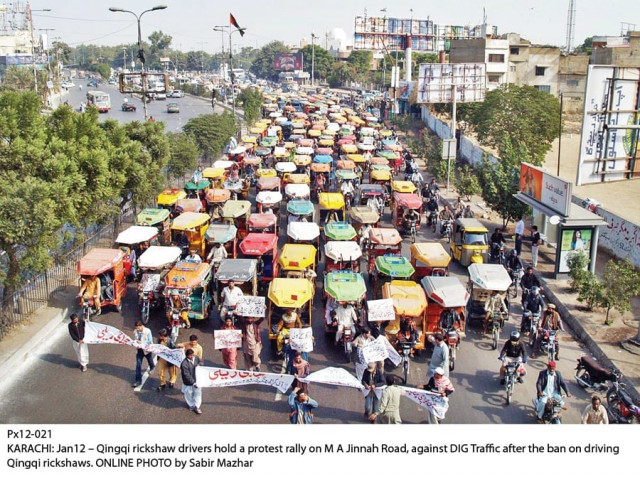Public transport: How the Chingchi broke the bus’s back in Karachi
Paratransit swept in because we don’t have mass transit
KARACHI:
Whoever masterminded the entrance of the chingchi on to the Karachi stage is a genius. This three-wheeler has emerged as a David to the minibus’s Goliath by capturing 66 per cent of the business.
“I don’t know who did it or how they studied the market but they broke the backbone of the minibus,” said engineer Ashar Lodhi, who was presenting at the Institute of Engineers of Pakistan Saturday.
In 2009, the chingchi appeared. It tapped into a market in which a majority of people using public transport in Karachi needs to travel short distances. “So, 66 per cent of total ridership for public transport is below 10kilometre (km), said Lodhi.”

It offered the lowest fare of a flat Rs10 per trip, which was less than the government allowed buses to charge. This coincided with the time that the buses and minibuses were converting to CNG.
Because chingchis were safer from muggings, cheaper and went short distances, they won. “When public transport shifted to chingchis, that killed the infrastructure,” said Lodhi. Buses were left with only 35 per cent of passengers. They began to struggle with CNG shortages and staying profitable. Since 2008 operating bus routes dropped 33 per cent from 149 to 101.
Meanwhile, variations of the chingchi emerged from a six- to a nine- and 12-seater. Its popularity grew and eventually it squeezed the bus out of the picture. When it captured the market it was able to muscle in more fare. “They are even charging higher than [buses],” Lodhi said. “They are able to get Rs40 for 20km.”
The chingchis have flooded the city also because they are taking advantage of a legal loophole. When the Motor Vehicle Ordinance was made in 1965, it defined what counted as public transport and set rules for it. But that was 50 years ago and the lawmakers didn’t foresee a three-wheeler emerging in this category. Lodhi explained: If you took a 200 cc chingchi to get registered it would be like me taking my car to register as a truck.
No registration also means chingchis are booked as ‘namaloom’ vehicles in FIRs if they are involved in an accident. The chingchi’s success was perhaps the work of a genius but it is only demand-and-supply economics. Karachi has continued to expand. When the bus network didn’t serve people and mass transit wasn’t developed, the chingchi filled that gap.
Instead of mass transit, the government concentrated over the last decade on laying more asphalt and building flyovers. “But do we need roads to carry vehicles or roads to carry people,” asked Lodhi. “Over the past decade we have been focusing on infrastructure, forgetting the need for people to travel.”
Public transport with 4.5 per cent of registered vehicles moves 42 per cent of people in Karachi. But private transport makes up 36 per cent of vehicles on the road but carries 21 per cent of people. Roads should be dedicated to buses that carry more people than cars. It is easier and more attractive to own a car and motorcycle whose numbers continue to rise. Mass transit has not been a priority. (The good news is that the federal government approved on Friday the Green line for mass transit to be run by the National Highway Authority.)
“Doing nothing is a decision,” warned Peter Armitage, an Asian Development Bank consultant, at the seminar. “It’s a decision to allow things to get worse.”
We have been hearing for the last ten years at least that the Karachi Circular Railway will be revived. Donor agencies such as the Japanese International Cooperation Agency have prepared plan after plan to improve Karachi’s transport. Malik Zaheerul Islam, who used to run the mass transit cell, remarked with frustration that the ADB gave $400 million once for mass transit but the government was asleep. In the meantime, Lahore has made progress. “Lahore has the Shahbaz factor at the top,” he said, referring to the chief minister who steamrolled their BRTS through. Ironically, the chingchis that Shahbaz Sharif threw out of Lahore ended up in Karachi!
Islam pointed out the difference: Government in Karachi sleeps at the top while pressure builds from the bottom. In Lahore, it is a top-down approach by the government. “They dictate and implement,” he said.
The association of chingchi owners says they are more than willing to work with the government. “Give us routes and registration,” said their representative Safdar Shah. “If institutions are silent, is that our fault? We’ve been asking since 2010.” He promised, that they were working on a new safer model with the reverse gear and better brakes so they pass fitness tests.
But the pride is unmistakable in his voice. The tiny chingchi has become a force to reckon with in just five years. “Chingchi ch’haa gaya, wo sara transport waise ka waisei he,” he declared. “We are mini public transport.”
The chingchi has arrived.
Published in The Express Tribune, December 1st, 2014.


COMMENTS (1)
Comments are moderated and generally will be posted if they are on-topic and not abusive.
For more information, please see our Comments FAQ